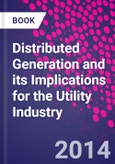Distributed Generation and its Implications for the Utility Industry examines the current state of the electric supply industry; the upstream and downstream of the meter; the various technological, business, and regulatory strategies; and case studies that look at a number of projects that put new models into practice.
A number of powerful trends are beginning to affect the fundamentals of the electric utility business as we know it. Recent developments have led to a fundamental re-thinking of the electric supply industry and its traditional method of measuring consumption on a volumetric basis. These developments include decreasing electricity demand growth; the rising cost of fossil fuels and its impact on electricity costs; investment in energy efficiency; increasing numbers of prosumers who generate for some or all of their own needs; and market reforms.
This book examines the implications of these trends in chapters focusing on distributed and decentralized generation, transactive energy, the role of electric vehicles, any much more.
Please Note: This is an On Demand product, delivery may take up to 11 working days after payment has been received.
Table of Contents
Foreword
Preface
Introduction
Part I: What is changing?
Chapter 1 Decentralized energy: Is it as imminent or serious as claimed? Chapter 2 New utility business model: A global view Chapter 3 Germany's decentralized energy revolution Chapter 4 Australia's million solar roofs: Disruption on the fringes or the beginning of a new order? Chapter 5 As the role of the distributor changes, so will the need for new technology Chapter 6 The impact of distributed generation on European power utilities Chapter 7 Lessons from other industries facing disruptive technology
Part II: Implications and industry/regulatory response
Chapter 8 Electricity markets and pricing for the distributed generation era Chapter 9 Transactive energy: Linking supply and demand through price signals Chapter 10 Transactive energy: Interoperable transactive retail tariffs Chapter 11 The evolution of the electric distribution utility Chapter 12 An expanded distribution utility business model: Win-win, or win-maybe? Chapter 13 From throughput to access fees: The future of network and retail tariffs Chapter 14 Industry response to revenue erosion from solar PVs Chapter 15 Making the most of the no growth business environment Chapter 16 Regulatory policies for the transition to new business paradigm Chapter 17 Electric vehicles: New problem, or distributed energy asset?
Part III: What future?
Chapter 18 Rethinking the transmission-distribution interface in a distributed generation future Chapter 19 Decentralized generation in Australia's National Electricity Market? No problem Chapter 20 What future for the grid operator? Chapter 21 Utility version 2.0: Maryland's pilot project Chapter 22 Turning a vision to reality: Boulder's utility of the future Chapter 23 Perfect storm or perfect opportunity? Future scenarios for the electricity sector Chapter 24 Evolution, revolution or back to the future: Lessons from the electricity supply industry's formative days
Epilogue








